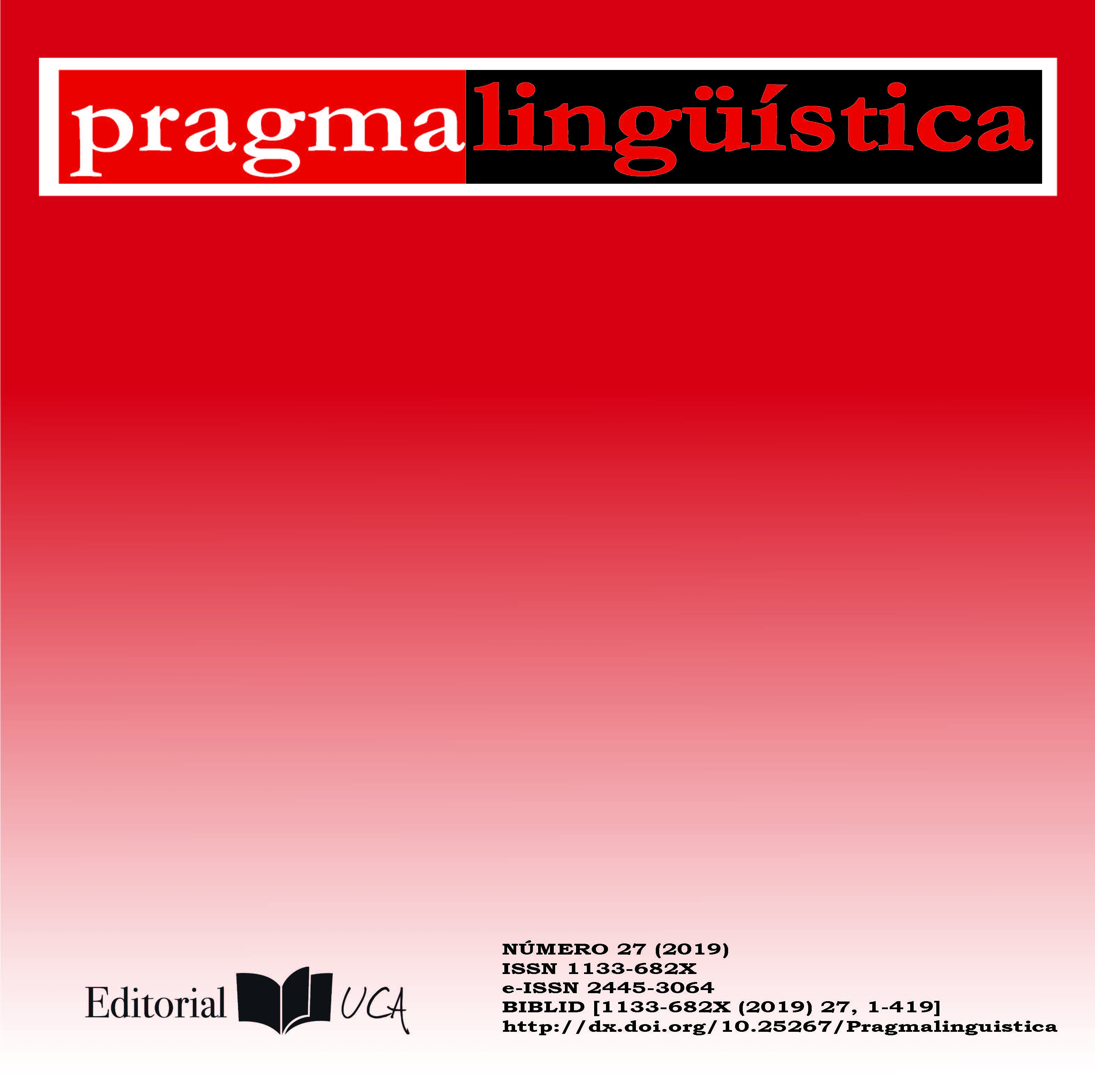Valeurs évidentielles de o eso dicen
Résumé
Dans cet article, nous analysons les valeurs évidentielles de la construction espagnole o eso dicen (‘ou comme on dit’). Nous examinons les différents modèles discursifs et syntaxiques dans lesquels cette construction apparaît et son utilisation en tant que marque d'évidentialité indirecte. L'analyse est faite à partir du Corpus de Español (section Web/Dialects) et se concentre sur la variété européenne de l'espagnol. Nous concluons que o eso dicen transmet différentes valeurs d’évidentialité, telles que rapport, rumeur et folklore, qui sont déterminées par des facteurs liés à la fixation de la construction, au type de source d’information et à la nature de la portée. En outre, on constate que cette construction sert souvent à montrer la distance ou le désaccord du locuteur avec l’information référée, bien que cette fonction semble être moins importante dans le cas d'utilisations en tant que marqueur de folklore.
Mots-clés
Téléchargements
Organismes de soutien
Comment citer
Licence

Ce travail est disponible sous licence Creative Commons Attribution - Pas d'Utilisation Commerciale - Pas de Modification 4.0 International.
Références
AIKHENVALD, A.Y. (2004): Evidentiality. Oxford: Oxford University Press.
AIKHENVALD, A.Y. (2007): “Information source and evidentiality: what can we conclude?”, Rivista Di Linguistica, 19(1), pp. 209-227.
AIKHENVALD, A.Y. (ed.) (2018): The Oxford Handbook of Evidentiality, Oxford: Oxford University Press.
ALBELDA, M. (2015): “Introduction: Evidentiality in non-evidential languages: Are there evidentials in Spanish?”, Journal of Pragmatics, 85, pp. 135-137.
ANDERBOIS, S. (2014): “On the exceptional status of reportative evidentials”, Proceedings of SALT, 24, pp. 234-254.
BERMÚDEZ, F. (2005): Evidencialidad. La codificación lingüística del punto de vista, tesis doctoral, Stockholm: Stockholms Universitet.
CHAFE, Wallace L. (1986): “Evidentiality in English Conversation and Academic Writing”, Chafe, W. L. y Nichols, J. (eds.): Evidentiality: The Linguistic Coding of Epistemology, Norwood, New Jersey: Ablex Publishing Corporation, pp. 261-272.
CORNILLIE, B. (2016): “Las lecturas evidenciales de los verbos (semi)auxiliares en español”, González Ruiz, R. et al. (eds.): La evidencialidad en español: teoría y descripción, Frankfurt am Main: Iberoamericana Vervuert, pp. 227-250.
DE LA MORA, J. y MALDONADO, R. (2015): “Dizque: Epistemics blurring evidentials in Mexican Spanish”, Journal of Pragmatics, 85, pp. 168-180.
ESCANDELL VIDAL, M.V. (2010): “Futuro y evidencialidad”, Anuario de Lingüística Hispánica, 25, pp. 9-34.
FALLER, M. (2002): Semantics and Pragmatics of evidentials in Cuzco Quechua, tesis doctoral.
GARCÍA NEGRONI, M. M. (2016): “Polifonía, evidencialidad citativa y tiempos verbales. Acerca de los usos citativos del futuro morfológico y del futuro perifrástico”, González Ruiz, R. et al. (eds.): La evidencialidad en español: teoría y descripción, Frankfurt am Main: Iberoamericana Vervuert, pp. 279-301.
GONZÁLEZ VÁZQUEZ, M. (2016): “La naturaleza y función de la evidencialidad en español”, González Ruiz, R. et al. (eds.): La evidencialidad en español: teoría y descripción, Frankfurt am Main: Iberoamericana Vervuert, pp. 49-74.
GRAS, P. (2016): “Entre la codificación y la inferencia. Los valores citativos de que inicial átono en español”, González Ruiz, R. et al. (eds.): La evidencialidad en español: teoría y descripción, Frankfurt am Main: Iberoamericana Vervuert, pp. 201-223.
HASSLER, G. (2010): “Epistemic modality and evidentiality and their determination on a deictic basis: the case of Romance languages”, Diewald, G. y Smirnova, E. (eds.): Linguistic Realization of Evidentiality in European Languages, Berlín-Nueva York: de Gruyter Mouton, pp. 223-248.
HARRIS, J.A. y POTTS, C. (2009): “Perspective-shifting with appositives and expressives” Linguistics & Philosophy, 32(6), pp. 523-552.
LAMPERT G. y LAMPERT, M. (2010): “Where does evidentiality reside? Notes on (alleged) limiting cases: seem and be like”, STUF - Language Typology and Universals Sprachtypologie und Universalienforschung, 63 (4), pp. 308-321.
LAZARD, G. (2001): “On the grammaticalization of evidentiality”, Journal of Pragmatics, 33, pp. 359-367.
MIGLIO, V.G. (2010): “Online databases and language change: The Case of Spanish dizque”, Gries, S.Th. et al. (eds.): Corpus Linguistics Applications: Current Studies, New Directions (Language and Computer Series), Amsterdam: Rodopi pp. 7-28.
PLUNGIAN, V. A. (2001): “The place of evidentiality within the universal grammatical space”, Journal of Pragmatics, 33, pp. 349-357.
PLUNGIAN, V. (2010): “Types of verbal evidentiality marking: an overview”, Diewald, G. y Smirnova, E. (eds.): Linguistic Ralization of Evidentiality in European Languages, Berlín-Nueva York: de Gruyter Mouton, pp. 15-58.
REYES, G. (1994): Los procedimientos de cita: citas encubiertas y ecos. Madrid: Arco/Libros.
RODRÍGUEZ ROSIQUE, S. (2015): “Distance, evidentiality and counter-argumentation: Concessive future in Spanish”, Journal of Pragmatics 85, pp. 181-199.
WILLET, T. (1988): “A Cross-Linguistic Survey of the Grammaticalization of Evidentiality”, Studies in Language, 12(1), pp. 51–97.







